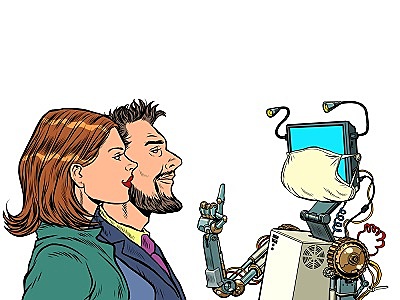Fighting COVID-19 with Pretty Machines
May 4, 2020

Today’s machines are even prettier than the cleverly rigged piece of rope Smith admires. They are robots that help enable the prosperity of modern society. And during this time of global epidemic, their result is more than mere diversion.

Today’s machines are even prettier than the cleverly rigged piece of rope Smith admires. They are robots that help enable the prosperity of modern society. And during this time of global epidemic, their result is more than mere diversion.
In Book I of The Wealth of Nations, Adam Smith talks about "very pretty machines" which "facilitated" and "quickened" the work of the common laborer. Smith is talking about a piece of rope, cleverly rigged to pull a lever, which allowed the attendant to be elsewhere while his engine worked. The innovation allowed him to "divert himself with his playfellows." Smith later discusses machines such as plows and mills which greatly increase productivity, bringing our attention to the beauty of machines that can greatly save labor. In modern times, especially during this global pandemic, machines-- like monitors and ventilators and delivery drones-- are saving lives around the world, in addition to just helping our productivity.
Today’s machines are even prettier than the cleverly rigged piece of rope Smith admires. They are robots that help enable the prosperity of modern society. And during this time of global epidemic, their result is more than mere diversion. By serving in hospitals, machines are reducing the risk of person-to-person transmission of the novel coronavirus. By undertaking routine tasks, machines reduce the pressure on medical professionals which frees them to perform more skilled work. Further, hospital staff, e.g. cleaners and food service workers, can avoid working in COVID patients' rooms, reducing the risk of exposure. Machines can also be sanitized in a way that is not possible for humans, who can unwittingly be carriers of the virus.
Robots have become commonplace on factory floors to the point where over 90 percent of robots today are employed in manufacturing. The productivity gains from their employment are well-documented. But robots also deserve credit for reducing deaths and injuries from the hot, heavy, and hazardous jobs, such as lifting heavy objects, using corrosive chemicals, and performing high-intensity welding. In this sense, using robots for dangerous tasks is very much a safety protection for people.
Robots provide invaluable assistance in warehouses where the single greatest source of workers’ compensation claims comes from the repetitive lifting, lowering, and moving of materials. Lifting heavy boxes and many tasks that lead to repetitive strain injury have been largely delegated to robots at many warehouses, including those of Amazon and Walmart, key fighters in ensuring compliance with essential, life-preserving public health efforts to keep everyone home and "flatten the curve." Efforts by these and other companies at keeping food and consumer goods supply chains and distribution facilities functional is vital to ensuring people receive necessities in a timely fashion. Additionally, social distancing requirements for human warehouse workers are irrelevant for robots, which are able to continue to work in close quarters.
In China, robot drones are completing the last fulfillment step in ensuring populations have access to essential goods, employing contactless goods and food delivery. In quarantine zones such as Wuhan, robots have been used to distribute food and hospital materials. Closer to home, robots are replenishing our store shelves. Robot duties even extend to growing the food that we are eating as it has become almost impossible for temporary agricultural workers to come from south of the border as they normally do at this time of year, not to mention the difficulty employers would have in housing those seasonal workers while respecting social distancing guidelines.
Sterilization robots roam the hospitals, employing disinfection chemicals and ultraviolet light. In addition to not exposing workers to the virus (as well as other pathogens of hospital-acquired infections), robots keep hospital cleaners from being repeatedly exposed to strong chemicals. Further, robots can reach - and disinfect - places that aren't easily accessible to people. These same technologies are being extended to other enclosed spaces, such as offices and airports, where essential workers are keeping businesses open and services running.
Additionally, for medical tasks undertaken in hospitals, robots are collaborating with doctors and nurses, helping ease the growing COVID-19-created pressure on systems that already work at close to capacity. For many years, surgical robots have been working to make surgeons more efficient, and surgeries easier to recover from. Now, robots are even doing some routine medical care, like checking vital signs and measuring fevers. Robots are delivering food, medicines, and other healthcare items throughout the hospitals. Given the extensive preparations needed to enter an affected patient’s room, including a ten minute process of donning a protective suit, the ability to delegate basic tasks such as taking out the trash to a robot can have huge safety and efficiency implications for both the system and patient care. Robots are even entertaining patients (how's that for a playfellow?)
In addition to the productivity and safety gains from robots in our workplaces, building up this infrastructure will serve as partial insurance against future shutdowns. Even the most automated plants, like Tesla, have had to shut down in this epidemic due to dangers to human supervisors. However, it is realistic to consider the potential, in a future pandemic scenario, for our robot partners to keep essential systems running while we stay at home.